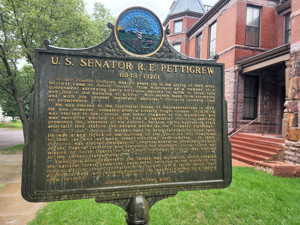“U.S. Senator R.F. Pettigrew (1848-1926)”

(Note: any text in italics has been taken from the official SDSHS records.)
Subject
A person and a place: Richard F. Pettigrew and his home in Sioux Falls.
Marker Text
Richard Franklin Pettigrew was 20 years old in the spring of 1869 when he first came to Dakota Territory from Wisconsin as a member of a government surveying party. Pettigrew decided to settle in Sioux Falls and join in the building of the city. With money made from surveying and with his unusual leadership abilities, Pettigrew quickly rose to prominence.
He was elected to the Territorial House of Representatives in 1872. He was, however, unseated after a bitterly fought contest. In 1876 he was elected to the Council, the upper chamber of the legislature, and was easily re-elected in 1878. As a legislator, Pettigrew zealously promoted the interests of his district. Because of his aggressive style and tall, thin stature, he became known as the ‘Pickerel Statesman’.
R.F. “Frank” Pettigrew worked hard to bring railroads to Sioux Falls. He was a key figure in the building of the Queen Bee Mill completed in 1881, as well as many other industrial developments. In 1880, Pettigrew was elected Delegate to Congress where he promoted division of the Dakota Territory and statehood for southern Dakota. Upon admission of South Dakota to the Union in 1889, Pettigrew was elected to the United States Senate.
Among his achievements in the Senate was legislation which created the national forest preserves. Because he believed in the worth of the individual over the corporation, he fought for a tariff which benefitted farmers and working people. He was re-elected to a second term in 1895.
In 1896 Pettigrew shocked America when he bolted the Republican national convention as an act of protest over the money controversy. He fought for ‘free silver’ and opposed the gold standard, again the champion of the common man over big business. This led him into Populism, and Pettigrew became one of the leaders of the People’s Party.
In 1899, in response to American aggression in the Philippine Islands, Pettigrew raised his voice in the Senate against imperialism, instead supporting the ideals of national self-determination.
Although he lost his Senate seat as a result of this fight, he emerged as one of the great American statesmen of his time. In an era when politicians were thought of as celebrities, his name became a household word.
After he left office, Pettigrew remained active in political and intellectual circles. In 1917, he was indicted under the Espionage Act for his opposition to America’s involvement in World War I. After the charges were dismissed, he authored two books based upon his experience in public office. In 1923, he built an addition on to his home to house his large collection of frontier artifacts. It was here that he died in 1926. He bequeathed his home and valuable collection to the city of Sioux Falls. The Pettigrew Home and Museum was opened to the public on January 1, 1930.
Dedication Note
Dedicated in 1995 by the Minnehaha County and South Dakota State Historical Societies, Midcontinent and Mary Chilton DAR Foundations, Citibank and Minnehaha Century Fund
Location
Minnehaha County, Pettigrew Museum, 131 N Duluth Ave, Sioux Falls (2006)
It’s just west of downtown Sioux Falls, on 8th Street.
Is there anything to see?
Yes, the home is preserved and is now a museum.
Marker Images


Other Images

Links to Additional Information
Wikipedia page for Richard F. Pettigrew
Web site for Pettigrew Home and Museum
Wikipedia page for The Queen Bee Mill
Wikipedia page for the Silver Republicans and the People’s Party, two political movements Pettigrew was involved with after leaving the Republican Party
National Archives newsletter about Pettigrew’s prosection (PDF) under the Espionage Act, including images of the indictment (scroll to page 3)
Every day, between 7,000 and 10,000 unique visitors come to this website. I don't keep analytics, so I have no idea why you're here. Maybe get in touch with me and tell me why you visited today?